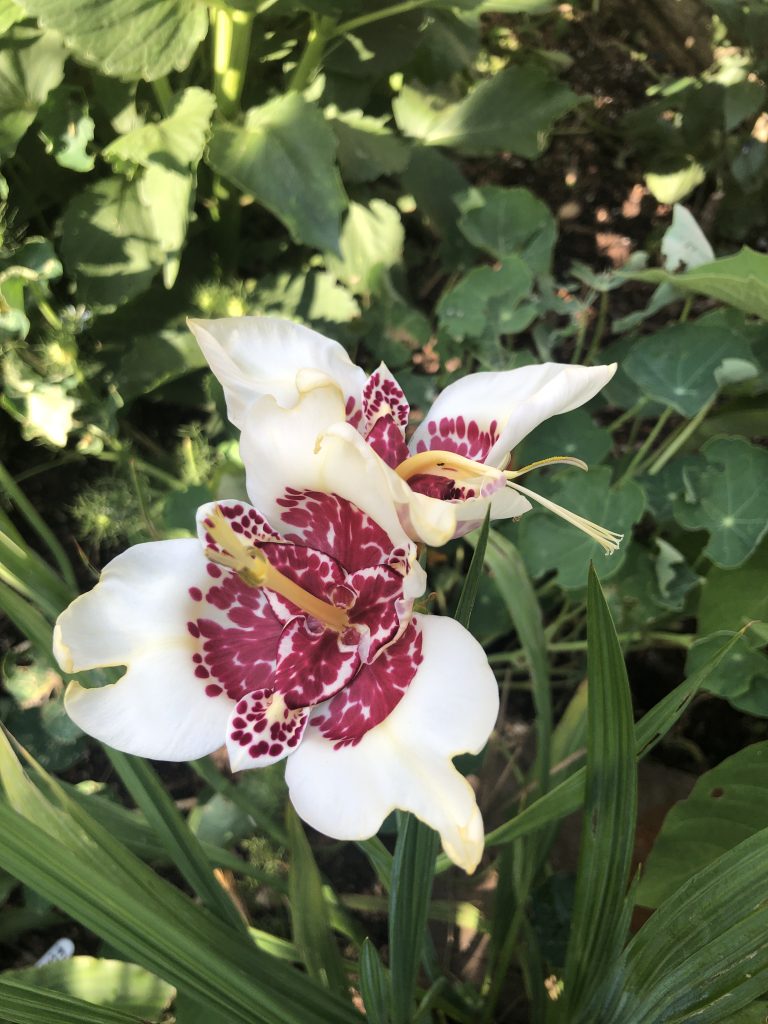Tigridia pavonia might be a short lived flower but when it opens, wow, what a flower! Tigridia pavonia flowers in July and August for about two to three weeks. For best flowers they should be planted in full sun. The flowers come in yellow, red, purple, and white
Although they’re native to warmer climates, they can thrive in the UK if given the right care. This guide covers everything you need to know about growing Tigridias in a British tropical-style garden, from selecting varieties to overwintering.
Choosing the Best Tigridia Varieties
Tigridia pavonia is the most commonly grown species and has multiple stunning varieties, each offering different vibrant colours and patterns:
- ‘Speciosa’: A deep red with a yellow-speckled center, ideal for making a bold, tropical statement.
- ‘Canariensis’: Sunny yellow petals with orange speckles and a red center, bringing warmth to the garden.
- ‘Alba’: White petals with pale yellow markings, a softer option for subtle contrast among lush foliage.
- ‘Lilacina’: Delicate pink or lilac petals with deep purple speckles, providing an unusual yet striking colour for a tropical theme.
Each flower lasts only one day, but with multiple blooms per stem, Tigridias put on a continuous show throughout summer.
Ideal Placement in a Tropical Garden
Tigridias thrive in sunny, sheltered spots that replicate the warmth of their native habitat. They pair well with other bold, leafy plants like cannas, bananas, or palms, adding brilliant color against the lush, green backdrop. Select a spot with full sun exposure and well-draining soil, as Tigridias dislike being waterlogged, especially in colder months. Consider raised beds or slight mounds to improve drainage and protect their roots.
Eye-Catching Colours and Plant Pairings
With their range of intense colors—red, yellow, white, pink, purple, and orange—Tigridias work well in combinations with other tropical garden plants. They make excellent companions for Crocosmia, Hedychium (ginger lilies), and dahlias, all of which share their vivid coloring and bring varied textures to the garden.
Caring for Tigridias in the UK
Though not as hardy as some bulbs, Tigridias are straightforward to care for during the growing season. Here’s a quick care guide:
- Planting Depth: Plant the corms 10-15 cm (4-6 inches) deep and 10-15 cm apart in the spring, once frost risk has passed.
- Watering: They prefer consistently moist soil, but avoid waterlogging. Regular watering during dry spells helps support flowering.
- Fertilizing: Apply a balanced, all-purpose fertilizer monthly from late spring to the end of flowering. This boosts growth and enhances bloom production.
- Aftercare: Tigridia blooms last a single day, so deadheading isn’t necessary. Allow the foliage to die back naturally, which will help feed the corms for next year’s growth.
Overwintering Tigridias
In the UK, Tigridias need protection from frost. The safest method is to lift and store corms indoors:
- In late autumn, after foliage has died back, carefully dig up the corms.
- Let them dry in a well-ventilated space for a few days.
- Store the corms in a paper bag or container filled with sand, peat moss, or vermiculite, keeping them in a frost-free spot between 5-10°C.
For milder UK areas, you may try leaving them in the ground under a thick mulch layer (such as bark, straw, or leaf mold) and additional fleece cover if needed.
Growing Tigridias adds vibrant, tropical color to UK gardens, rewarding with stunning blooms and an exotic flair that enhances any tropical-themed setting. With the right planting, care, and winter protection, Tigridias will become a dazzling addition to your garden year after year.

